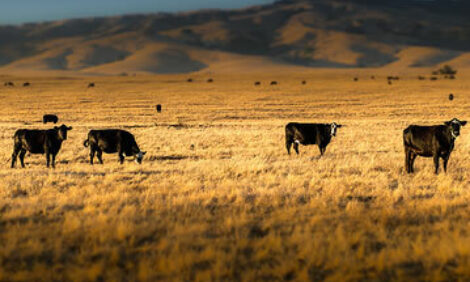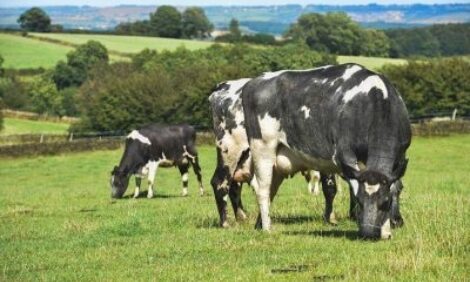



Bull Nutrition- Achieving Yearling Breeding
'Letting down' conditioned bulls, building up underweight bulls and the importance of annual nutritional plans are discussed by beef specialists at South Dakota University.
Bull nutrition is often overlooked by many producers, except when problems arise. Bulls are often managed as one group even though there may be large differences in age, size, and body condition. Seedstock producers are the primary individuals managing the development program of bulls being sold. For commercial producers, feeding programs usually include feeding purchased bull(s) from delivery until the breeding season and bulls retained from one breeding season to the next.
The debate over the correct method for developing bulls is not settled: Should you develop bulls at a moderate rate of gain? Or should you develop bulls on a ration that is capable of supporting high rates of gain so genetic differences can be measured for selection and marketing purposes?
Bulls put into many bull test stations are placed on rations to support high rates of gain. Many seedstock producers have established specific feeding programs to fit the desired animal performance (where bulls show their genetic potential and are cost efficient).
While the effect of underfeeding is obvious, overfeeding bulls also has negative effects on reproductive performance. Excess external fat cover is found not only on the back of the bull but also in the bull’s scrotum. This increases the temperature in the scrotum, which reduces both sperm production and the quality of stored sperm. Being overly fat also increases stress on the bull and limits his ability to travel and search out and service cows that are in heat.
This publication focuses on nutrient requirements for developing bulls, feeding programs to “let down” overconditioned bulls, and feeding during the period between breeding seasons.
Pre-weaning Nutrition
Traditional management of beef calves (including bulls) is to maintain them on their dam until normal weaning at 6 to 9 months of age. Under normal environments, the plane of nutrition from dam’s milk and forage should be adequate for normal growth rates of bull calves. Management options such as early weaning or creep feeding can be considered when the calves’ plane of nutrition is less than desired.
Post-weaning Nutrition
Post-weaning to first breeding season is when producers normally start to determine rations. We suggest developing bulls at moderate rates of gain instead of high rates of gain. Since bull selection is based on genetic information such as EPDs, more producers are using a moderate plane of nutrition to develop breeding bulls during the postweaning phase. The nutrient requirements for growing bulls are shown in table 1. Daily nutrient requirements are shown for maintenance and several rates of gain to allow producers to select desired average daily gain. NRC (2000) provides protein requirements based on metabolizable protein; however, protein requirements reported herein are converted to a crude protein basis. Once the desired average daily gain is selected, add the maintenance and gain levels for each nutrient to determine the total nutrients required. There are many possible rations that could be used to develop bulls at the desired animal performance prior to the first breeding season. The best ration depends heavily on the availability and cost of feed ingredients. The key is developing the ration to meet the desired animal performance.
Table 1. Daily Nutrient Requirements for Growing Beef Bull Calves Post-weaning (Mature Size = 2000 lb.)

Crude protein calculated from metabolizable protein requirement based on coefficient from NRC (2000).
During the post-weaning period both under- and overnutrition can have negative impacts. Undernutrition results in delayed puberty, and overnutrition can reduce semen production and quality. Limited data is available in the area of bull nutrition. Diets should be balanced to meet the nutrient requirements for the desired animal performance and body condition score should be monitored to ensure that the bulls are not being under- or overnourished. Typically, many of these diets to develop beef bulls appear to contain from 40 to 60% concentrate. For breeds that are known to reach puberty later, a common practice is to place the bulls on a slightly higher plane of nutrition (60 to 70% concentrate). The theory is to hasten the onset of puberty; however, with breeds that reach puberty early, additional energy is not beneficial and may cause overconditioned animals.
Conditioning Prior to the Breeding Season
Yearling bulls should have a body condition score of 5.5 to 6.5 (on a 9-point scale) at the start of the breeding season. Once body condition has been assessed, management is needed for over-conditioned bulls and thin bulls. If yearling bulls are over-conditioned they need to be “let down” to prepare them for the breeding season. Gradual changes are needed when changing diets to be more or less concentrated to reduce the possibilities of metabolic disorders and impaired breeding performance. Because mature sperm is produced over a 60-day period before ejaculation, nutritional effects of over- or underfeeding on sperm quantity and quality will have some carryover effect. The general method of stepping down bulls is to gradually replace a portion of the concentrate in the ration with forage over several weeks until the bulls are consuming forage or forage plus a supplement. Ideally, this should start at least 30 to 60 days prior to turn-out, and yearling bulls should continue to gain 1.5 to 2.0 pounds per day.
Thin bulls should be put on a ration with a higher level of energy to increase rate of gain. If bulls purchased or previously in your ownership are in good condition, you will need to ensure that they are adapted to high-forage rations prior to turn out.
Breeding Season Nutrition
There is limited opportunity to manage bull nutrition during the breeding season; the bulls are basically on the same plane of nutrition as the cows. However, you should assess the body condition score of bulls during the breeding season as well as observe the bulls’ ability to service the cows. Bulls often lose from 100 to 200 pounds during the breeding season. A bull that gets extremely thin during the breeding season may want to be replaced because his ability to service the cows will probably be reduced.
Post-breeding Season
Nutritional management post-breeding is influenced both by the age of bulls and by the amount of weight loss bulls experience during the course of the breeding season. Once the breeding season is over, producers usually turn bulls out to a separate pasture to regain lost weight and prepare them for the next breeding season. Mature bulls in fairly good condition after the breeding season can be managed on pasture or an allroughage diet without supplements during the winter. Hay quality should be 8 to 10% crude protein and be fed at 2% of body weight. Rations should be modified based on available feed ingredients and to manage the bulls to maintain moderate body condition.
Nutrient requirements for mature bulls at lower rates of gain are provided in table 2.
Table 2. Daily Nutrient Requirements for Maintenance and Gain (Regain Body Condition) of Young and Mature Bulls

* ADG = Average Daily Gain
Crude protein calculated from metabolizable protein requirement based on coefficient from NRC (2000).
Young bulls are still growing so the ration should be formulated to gain 1.5 to 2.0 pounds per day, depending on the magnitude of weight loss during breeding. The need to supplement young bulls on summer/fall pasture will depend on the quality and quantity of forage available. The best method for developing a diet for bulls is to test potential feeds and formulate a ration based on age, size, and desired performance. For example, during the winter feeding program, feeding roughage at 2% of body weight plus 3.0 to 6.0 pounds of grain (so total diet protein content is 10 to 11%) will often provide the targeted rate of gain in young bulls.
Minerals and Vitamins
This publication does not address mineral and vitamins nutrition in depth in bull diets. However, minerals and vitamins are important for successful animal growth and breeding performance. Provide a good mineral and vitamin program for your bulls as well as your cows.
Two Breeding Seasons Per Year
Some producers have both spring and fall calving herds, hence double-using bulls. This puts additional management responsibilities onto these producers, as these producers must ensure that bulls will be prepared to serve cows at each breeding season. With two breeding seasons per year, bulls have a shorter time to replenish their weight loss before the next breeding season. Young bulls may need to gain 2.0 to 2.5 pounds per day to recover from weight loss.
Summary
Seedstock and commercial beef producers want quality beef bulls that are capable of breeding cows as a yearling (producing quality semen) and are physically able to seek out cows and heifers on pasture. Nutritional management plays an important role in ensuring that they can fulfill expectations.
Original Authors:
Julie Walker | Extension Beef Specialist
George Perry | Beef Reproduction Management Specialist
Ken Olson | Extension Beef Specialist
March 2013


